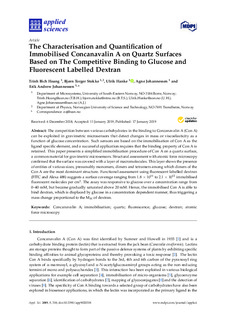The Characterisation and Quantification of Immobilised Concanavalin A on Quartz Surfaces Based on The Competitive Binding to Glucose and Fluorescent Labelled Dextran
Journal article, Peer reviewed
Published version
Permanent lenke
http://hdl.handle.net/11250/2623517Utgivelsesdato
2019Metadata
Vis full innførselSamlinger
- Institutt for mikrosystemer [520]
- Publikasjoner fra CRIStin [3401]
Sammendrag
The competition between various carbohydrates in the binding to Concanavalin A (Con A) can be exploited in gravimetric microsensors that detect changes in mass or viscoelasticity as a function of glucose concentration. Such sensors are based on the immobilisation of Con A as the ligand specific element, and a successful application requires that the binding property of Con A is retained. This paper presents a simplified immobilisation procedure of Con A on a quartz surface, a common material for gravimetric microsensors. Structural assessment with atomic force microscopy confirmed that the surface was covered with a layer of macromolecules. This layer shows the presence of entities of various sizes, presumably monomers, dimers and tetramers among which dimers of the Con A are the most dominant structure. Functional assessment using fluorescent labelled dextran (FITC and Alexa 488) suggests a surface coverage ranging from 1.8 × 1011 to 2.1 × 1012 immobilised fluorescent molecules per cm2. The assay was responsive to glucose over a concentration range from 0–40 mM, but became gradually saturated above 20 mM. Hence, the immobilised Con A is able to bind dextran, which is displaced by glucose in a concentration dependent manner, thus triggering a mass change proportional to the MW of dextran.
Beskrivelse
This article is an open access article distributed under the terms and conditions of the Creative Commons Attribution (CC BY) license.

